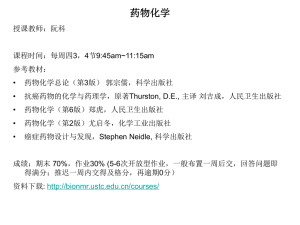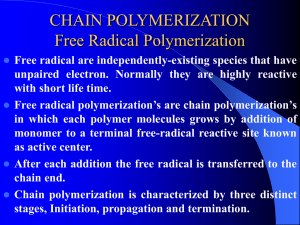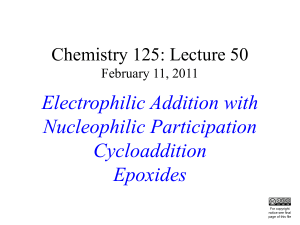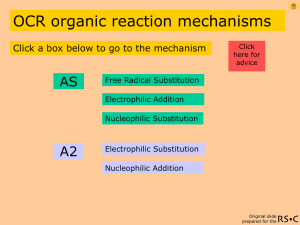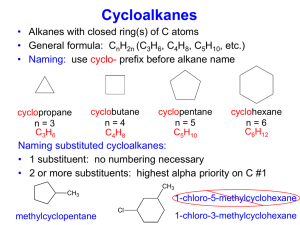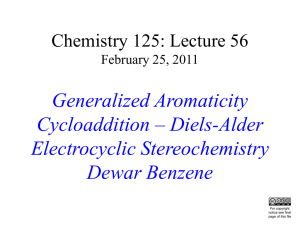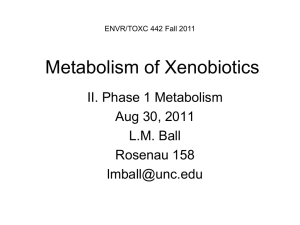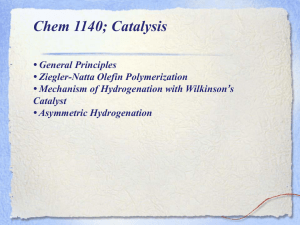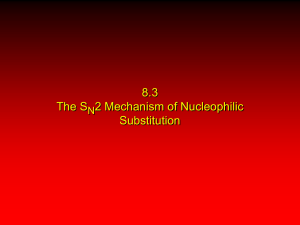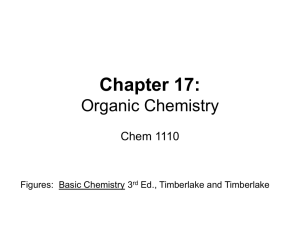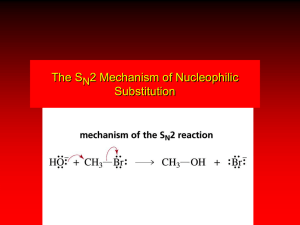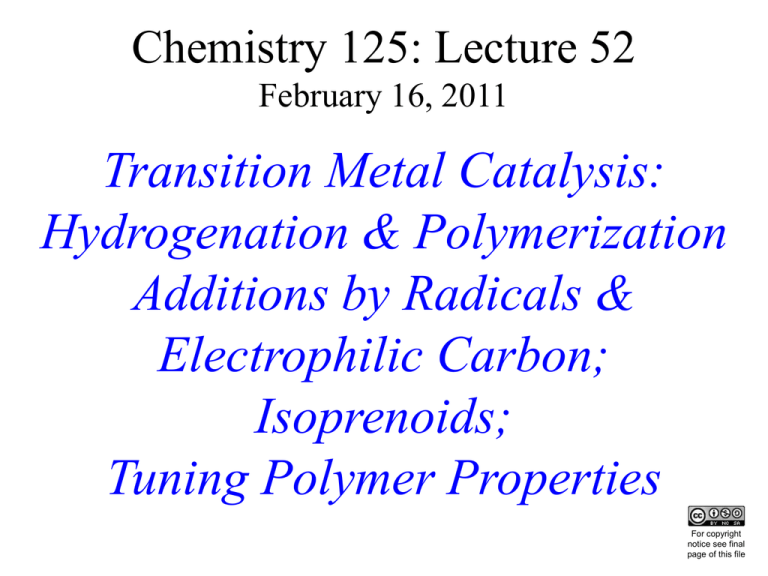
Chemistry 125: Lecture 52
February 16, 2011
Transition Metal Catalysis:
Hydrogenation & Polymerization
Additions by Radicals &
Electrophilic Carbon;
Isoprenoids;
Tuning Polymer Properties
This
For copyright
notice see final
page of this file
Other “Simultaneous” Reagents
RC
O
Cl2C: (Carbene)
R2BH (Hydroboration)
CH2I2 Zn/Cu (Carbenoid)
(Epoxidation)
O3 (Ozonolysis)
OOH
OsO4 or MnO4 (Dihydroxylation)
H-metal (Catalytic Hydrogenation)
R-metal (Metathesis, Polymerization)
e.g. J&F Sec. 10.5c p. 443
OsO4 and Permanganate
“NMO”
(1976 - Upjohn)
H2O2 (1936)
H-O-H
O
O
Chiral
Amine
Ligand
O
O
K+
O-
O
to trans 2-butene
(1988)
OsO4 is poisonous and expen$ive!
Use as a 1% catalyst by adding oxidant.
O
Mn
O
Os
Os analogue
O
O
HO O OH
of
C
cyclic
acetal
H
CH3
C CH
C C
H C(S,S)
3
H
H 3C
H3C + (R,R) H
syn addition
Sharpless Osmate
Asymmetric
Dihydroxylation
Ester
Os
K+
O-
Mn
O
H2O
HO O
C
C
OH
C
KMnO4
MeOH / H2O
NaOH, 20°C
OH
85%
yield
SAD
OH
97% ee
all syn
Catalytic Hydrogenation
HOMO/LUMO : Concerted (“works” with metal catalysts!)
*HOMO
LUMO
*
LUMO
HOMO
H H
Pd H
H
H H orthogonal H H
HOMO-HOMO repulsive
C
C
C
C
C
C
HOMO
empty
C
C
*LUMO
e.g. J&F Sections Sec 4.9A, 168ff., 10.2a (410-413), 10.10 (452)
Orbital Variety
from Metals
47% C-H
Ethylene
Ethylene-Pd
Complex
Pd
…(4d)10 (5s) 0 (5p)0
HOMO
LUMO (
())
13%
HOMO-4
40% 4dxy
HOMO (4dxyz
22-y2)
xy
zxz
67%
Ethylene
HOMO ()
Ethylene-Pd
Complex
HOMO
Pd
0 (5p)0
(4d)10 (5s)
15%
4dz2
+
UMO (5p)
HOMO (4d)
UMO (5s)
6% 5s
5% 5p
Sigma Bond Analogue
“Oxidative” Addition (crummy PM3 calculation)
H-H
+
Pd
10
splitting H2
5
0
H2 dissociates on bulk Pd surface, then hydrides move.
(entropy help)
kcal/mole
bonding
H2 to Pd
kcal/mole
Catalytic Hydrogenation
“oxidative addition”
C
C
C
Pd
“oxidative addition”
C
H
Pd
H
H
Pd
“reductive elimination”
H
Pd
“reductive elimination”
Experts discuss the extent of
bonding in this “-complex”
H
H
Pd
H
H
H
Pd addition concerted
(syn)
Pd
H
H
H
Pd
Pd
H atoms replace Pd frontside
syn hydrogenation product
Catalytic Hydrogenation
Stereochemistry
syn addition
e.g. J&F pp. 412
Stereochemistry
A general elementary text
e.g. Loudon, Sec. 7.9 E p. 313
No yields
specified!
No literature
reference!
pp. 20-22 of H. O. House
Modern Synthetic Chemistry
(1972)
(a graduate-level text)
J. Chem. Soc., 1354 (1948)
allylic isomers
H2 / Pt
R’ = Ac
R’ = Ac
Catalytic Hydrogenation
Suppose
there
an allylic
H in the alkene:
can lead
to isallylic
rearrangement
HC
HC
C
CH
H
C
H
C
Pd
symmetric
H C
Pd
alkene
isomerized
CH
C
H
C
Pd
H
CH
C
C
Pd
H
H
H
Pd
H
Pd
4
3
2
VII
1
10
9
5
8
4
6
3
7
2
5
10
1
9
6
7
8
VIII
??
Alkene Metathesis
C
C
Ru
Grubbs
Catalyst
a metal
alkylidene
complex
Nobel Prize
2005
Ru
C
C
C
Ru
metallacyclobutane
Ru
Ru
Tourists
Ziegler
Grubbs
Host
Prof. S.-I. Murahashi
Tall Prof. F. Ziegler
(not Prof. Karl Ziegler)
with Prof. R. Grubbs
ROMP
Ring-Opening Metathesis Polymerization
metathesis
Ru
C
C
Ru
metatheses
n
C
Ru
n
isotactic CH3
-(CH -CH ) - Hydrogenation
Catalytic
-(CH -CH) 2
2 n
2
n = 800-250,000
H
H
Pd
106
25 x
tons
(2004)Pd
Et3Al + TiCl4
H
n
n up to 105
H
6 tons
45
x
10
H
(2007)
Pd
H
H
Pd
hard to study
mechanism
Heterogeneous Catalyst
Ziegler-Natta Polymerization
R
Ti
R
Ti
R
Ti
R
Stereochemistry: Tacticity
How do you
How do you know which is which?
what you make?
NMR
(coming soon)
All head-to-tail, and stereoregular (isotactic)
All head-to-tail, and stereoregular (syndiotactic)
All head-to-tail, but stereorandom (atactic)
Stereochemistry: Tacticity
Alkenes approach
from alternate faces
achiral
faces
mirror
enantiotopic
faces
axis
Homogeneous
“Kaminsky”
catalysts
homotopic
activatedfaces
by MAO
+
R2B-H
C=C-CH
C=C-CH
33
C
-C-CH3
R
C-C-CH
R
R’
C-C-CH
R’
3
(“methyaluminoxane”)
All head-to-tail, and stereoregular (isotactic)
All head-to-tail, and stereoregular (syndiotactic)
All head-to-tail, but stereorandom (atactic)
Radical Polymerization
(e.g. J&F Sec 11.5 pp.487-489)
R
H
Occasional butyl side-chains
inhibit close packing.
Controlling Polymer Chain Length
CCl4 is a “Chain-Transfer Agent”
shortens polymer molecules
without terminating chain reaction
ktransfer/kpolymerization ~ 0.01 for styrene polymerization
R
When other termination is
negligible, molecular length
~ kp[styrene] / kt[CCl4]
“dispersity”
Cl
Cl CCl3
Properties like viscosity and
melting point depend on
chain length.
etc.
(“oligo”, a few)
Alkene/Diene Oligomerization
and Polymerization Using
Carbon Electrophiles
R-L
(SN2)
+
R
(SN1)
*
+
R
Electrophile in Formation of
2,2,4-Trimethylpentane, “Isooctane”
(defined as “100 octane”)
H+
H
CH3
CH
CH33
CH3 C CH
H +
H22C
C C
C
3 H
CH3
H2SO4
CH
CH33
CH3
CH3
CH3 C CH2 C H
CH3
CH3
inter molecular hydride shift
(Bartlett, 1944)
CH3
CH3
CH3 C +
CH3
poly(isobutylene)
“butyl rubber”
air-tight
etc.
etc.
CH3
CH3 C CH2 C+
CH3
CH3 C CH2
CH3
CH3
CH3
CH3
chain
C CH2 C+
CH3
CH3
CH3
+
R-L and
*
+
R
Electrophiles in
Terpene/Steroid Biogenesis
e.g. J&F Sec. 12.13 pp. 554-562
End of Lecture 52
February 16, 2011
Copyright © J. M. McBride 2011. Some rights reserved. Except for cited third-party materials, and those used by visiting
speakers, all content is licensed under a Creative Commons License (Attribution-NonCommercial-ShareAlike 3.0).
Use of this content constitutes your acceptance of the noted license and the terms and conditions of use.
Materials from Wikimedia Commons are denoted by the symbol
.
Third party materials may be subject to additional intellectual property notices, information, or restrictions.
The following attribution may be used when reusing material that is not identified as third-party content:
J. M. McBride, Chem 125. License: Creative Commons BY-NC-SA 3.0

